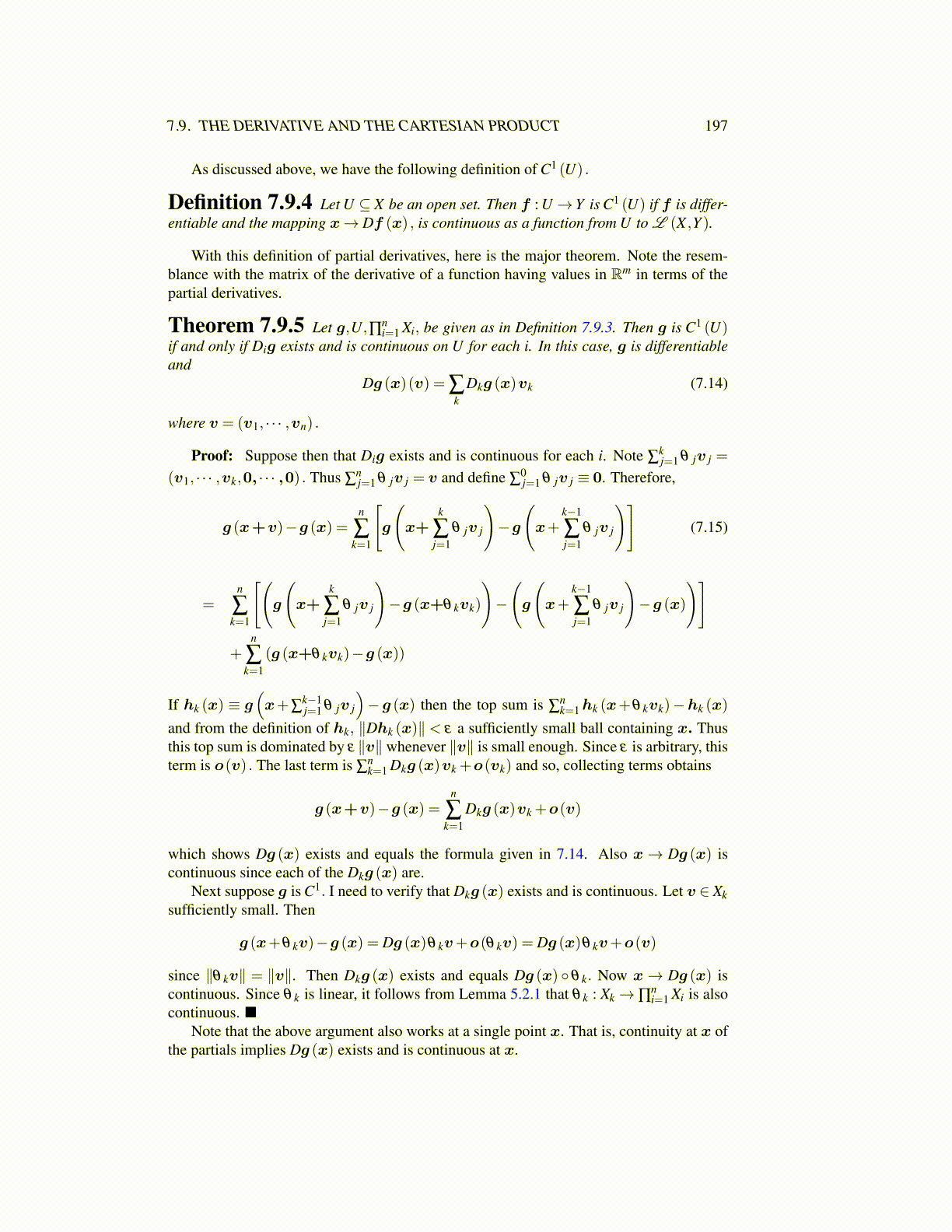
7.9. THE DERIVATIVE AND THE CARTESIAN PRODUCT 197
As discussed above, we have the following definition of C1 (U) .
Definition 7.9.4 Let U ⊆ X be an open set. Then f : U →Y is C1 (U) if f is differ-entiable and the mapping x→ Df (x) , is continuous as a function from U to L (X ,Y ).
With this definition of partial derivatives, here is the major theorem. Note the resem-blance with the matrix of the derivative of a function having values in Rm in terms of thepartial derivatives.
Theorem 7.9.5 Let g,U,∏ni=1 Xi, be given as in Definition 7.9.3. Then g is C1 (U)
if and only if Dig exists and is continuous on U for each i. In this case, g is differentiableand
Dg (x)(v) = ∑k
Dkg (x)vk (7.14)
where v = (v1, · · · ,vn) .
Proof: Suppose then that Dig exists and is continuous for each i. Note ∑kj=1 θ jv j =
(v1, · · · ,vk,0, · · · ,0) . Thus ∑nj=1 θ jv j = v and define ∑
0j=1 θ jv j ≡ 0. Therefore,
g (x+v)−g (x) =n
∑k=1
[g
(x+
k
∑j=1
θ jv j
)−g
(x+
k−1
∑j=1
θ jv j
)](7.15)
=n
∑k=1
[(g
(x+
k
∑j=1
θ jv j
)−g (x+θ kvk)
)−
(g
(x+
k−1
∑j=1
θ jv j
)−g (x)
)]
+n
∑k=1
(g (x+θ kvk)−g (x))
If hk (x) ≡ g(x+∑
k−1j=1 θ jv j
)− g (x) then the top sum is ∑
nk=1hk (x+θ kvk)−hk (x)
and from the definition of hk, ∥Dhk (x)∥ < ε a sufficiently small ball containing x. Thusthis top sum is dominated by ε ∥v∥ whenever ∥v∥ is small enough. Since ε is arbitrary, thisterm is o(v) . The last term is ∑
nk=1 Dkg (x)vk +o(vk) and so, collecting terms obtains
g (x+v)−g (x) =n
∑k=1
Dkg (x)vk +o(v)
which shows Dg (x) exists and equals the formula given in 7.14. Also x→ Dg (x) iscontinuous since each of the Dkg (x) are.
Next suppose g is C1. I need to verify that Dkg (x) exists and is continuous. Let v ∈ Xksufficiently small. Then
g (x+θ kv)−g (x) = Dg (x)θ kv+o(θ kv) = Dg (x)θ kv+o(v)
since ∥θ kv∥ = ∥v∥. Then Dkg (x) exists and equals Dg (x) ◦ θ k. Now x→ Dg (x) iscontinuous. Since θ k is linear, it follows from Lemma 5.2.1 that θ k : Xk→∏
ni=1 Xi is also
continuous. ■Note that the above argument also works at a single point x. That is, continuity at x of
the partials implies Dg (x) exists and is continuous at x.